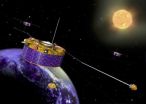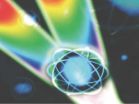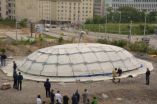(Press-News.org) Space is not empty. A wind of charged particles blows outwards from the Sun, carrying a magnetic field with it. Sometimes this solar wind can break through the Earth's magnetic field. Researchers at the Swedish Institute of Space Physics (IRF) in Uppsala now have an answer to one of the questions about how this actually occurs.
When two areas with plasma (electrically charged gas) and magnetic fields with different orientations collide, the magnetic fields can be "clipped off" and "reconnected" so that the topology of the magnetic field is changed. This magnetic reconnection can give energy to eruptions on the solar surface, it can change the energy from the solar wind so that it then creates aurora, and it is one of the obstacles to storing energy through processes in fusion reactors.
If two colliding regions of plasma have the same density, temperature and strength (but different orientation) of their magnetic fields, symmetrical reconnection begins. Scientists understand much about this process. But more usual in reality is that two regions of plasma have different characteristics, for example when the solar wind meets the environment round the Earth. Daniel Graham at IRF has recently published a detailed study of this asymmetrical magnetic reconnection in Physical Review Letters 112, 215004 (2014).
The study uses data from the four European Space Agency satellites in the Cluster mission, satellites which fly in formation in the Earth's magnetic field.
"Especially important were measurments with two satellites only a few tens of kilometres from each other, in the region where the solar wind meets the Earth's magnetic field," says Daniel Graham. "We can thus do detailed measurements to understand plasma physics at a height of 60,000 km."
Heating of electrons parallel to the magnetic field in conjunction with magnetic reconnection is of especial interest.
"We believe that this is an important piece of the puzzle for understanding how magnetic reconnection works, how charged particles are accelerated, and how particles from different regions can be mixed with each other," says Daniel Graham.
"Our detailed measurements in the Earth's magnetic field can be used to understand the physics even in fusion reactors on Earth, and in far distant regions in space that we can't reach with satellites."
INFORMATION: END
The solar wind breaks through the Earth's magnetic field
A wind of charged particles blows outwards from the sun, carrying a magnetic field with it; Sometimes this solar wind can break through the Earth's magnetic field
2014-06-11
ELSE PRESS RELEASES FROM THIS DATE:
It's the last bite that keeps you coming back for more
2014-06-11
Your memory for that last bite of a steak or chocolate cake may be more influential than memory for the first bite in determining when you want to eat it again, according to research published in Psychological Science, a journal of the Association for Psychological Science.
Our memories for foods are often vivid, especially when we experience foods that are terrifyingly bad or delightfully good. The findings from this research shed light on how memories for food are formed and how they guide our decisions about how soon we're willing to eat a food again.
"Research has ...
Obesity gene linked to hormonal changes that favor energy surplus
2014-06-11
A new study from Uppsala University demonstrates that elderly humans carrying a common variant of the fat mass and obesity gene FTO also have a shifted endocrine balance. Low blood concentrations of the satiety hormone leptin and high blood concentrations of the hunger promoting hormone ghrelin makes carriers of the FTO gene put on weight. The findings are published in the journal Diabetes.
In the Prospective Investigation of the Vasculature in Uppsala Seniors, researchers from Uppsala University and the University of Umeå used data from 985 elderly participants (50% ...
Toward 24-7 glucose monitoring to help manage diabetes
2014-06-11
Nearly half a million people with diabetes end up in emergency rooms around the U.S. every year due to the seizures and other consequences of dropping or spiking blood-sugar levels associated with the disease. To help prevent serious complications, scientists have now developed a new glucose-sensing protein that could one day be part of an implantable, 24-7 monitoring device. They describe the protein in the journal ACS Chemical Biology.
Sylvia Daunert and colleagues note that scientists have been working on new ways to track glucose levels. Most patients with diabetes ...
American Heart Association conference highlights solutions for reducing sodium intake
2014-06-11
11 June 2014 – Sodium intake around the world continues to be of concern1 and public health authorities hypothesise that it may be linked with cardiovascular disease risk2. In an effort to identify ways to reduce the amount of sodium consumed and provided in the food supply, the American Heart Association brought together over 100 key stakeholders and thought leaders at a special conference in June 2013. Proceedings from the conference were published in the May 2014 edition of Circulation3.
Among the top priorities identified by the group were increasing consumer understanding ...
Gauging local illicit drug use in real time could help police fight abuse
2014-06-11
The war on drugs could get a boost with a new method that analyzes sewage to track levels of illicit drug use in local communities in real time. The new study, a first-of-its-kind in the U.S., was published in the ACS journal Environmental Science & Technology and could help law enforcement identify new drug hot spots and monitor whether anti-drug measures are working.
Kurunthachalam Kannan and Bikram Subedi note that to date, most methods to estimate drug use in the U.S. are based on surveys, crime statistics and drug seizures by law enforcement. But much illegal drug ...
Viewing deeper into the quantum world
2014-06-11
One of the important tasks for quantum physics researchers and engineers is designing more sensitive instruments to study the tiny fields and forces that govern the world we live in. The most precise measuring instruments devised to date, such as atomic clocks or gravitational wave detectors, are interferometric in nature and operate according to the laws of quantum mechanics.
As with all quantum objects, photons – the basic building blocks of light - display a "wave-particle" duality. Interferometers exploit the wave-like behaviour of photons to measure a signal, known ...
Study finds cognitive performance can be improved in teens months, years after traumatic brain injury
2014-06-11
Traumatic brain injuries from sports, recreational activities, falls or car accidents are the leading cause of death and disability in children and adolescents. While previously it was believed that the window for brain recovery was at most one year after injury, new research from the Center for BrainHealth at The University of Texas at Dallas published online today in the open-access journal Frontiers in Neurology shows cognitive performance can be improved to significant degrees months, and even years, after injury, given targeted brain training.
"The after-effects ...
Guarding against 'Carmageddon' cyberattacks
2014-06-11
The potential value of turning the nation's freeways into "smart transportation systems" is enormous. Equipping the nation's concrete arteries with a nervous system of computers and sensors that directly control on-ramp signals to keep traffic moving smoothly can substantially reduce travel times, fuel consumption and air pollution, not to mention improve road safety. In California alone the economic penalty of traffic congestion has been estimated at $400 million in extra costs and $3.5 million in lost wages every day.
The tightly integrated computing and networking ...
Elucidating optimal biological tissue shape during growth
2014-06-11
A team of European scientists has now extended a previous biophysical model to investigate elongated growth within biological tissues by describing the evolution over time of the shape of a fruit fly's wing. They found the aspect ratio of the typical biological shapes may exhibit a maximum at finite time and then decrease. For sufficiently large tissues, the shape is expected to approach that of a disk or sphere. These findings have been reported by Carles Blanch-Mercader from the University of Barcelona, Spain, and colleagues, in a paper published in EPJ E. They provide ...
The inflatable concrete dome
2014-06-11
This news release is available in German.
Large shell structures made of concrete or stone are hardly ever built any more. The reason is that their construction requires large, expensive supporting structures. At the Vienna University of Technology, a completely new construction method has been developed, which does not require any timber structures at all: a flat concrete slab hardens on the ground, and then an air cushion below the plate is inflated, bending the concrete and quickly forming a sustainable shell. Even large event halls could be built this way. In ...
LAST 30 PRESS RELEASES:
First Editorial of 2026: Resisting AI slop
Joint ground- and space-based observations reveal Saturn-mass rogue planet
Inheritable genetic variant offers protection against blood cancer risk and progression
Pigs settled Pacific islands alongside early human voyagers
A Coral reef’s daily pulse reshapes microbes in surrounding waters
EAST Tokamak experiments exceed plasma density limit, offering new approach to fusion ignition
Groundbreaking discovery reveals Africa’s oldest cremation pyre and complex ritual practices
First breathing ‘lung-on-chip’ developed using genetically identical cells
How people moved pigs across the Pacific
Interaction of climate change and human activity and its impact on plant diversity in Qinghai-Tibet plateau
From addressing uncertainty to national strategy: an interpretation of Professor Lim Siong Guan’s views
Clinical trials on AI language model use in digestive healthcare
Scientists improve robotic visual–inertial trajectory localization accuracy using cross-modal interaction and selection techniques
Correlation between cancer cachexia and immune-related adverse events in HCC
Human adipose tissue: a new source for functional organoids
Metro lines double as freight highways during off-peak hours, Beijing study shows
Biomedical functions and applications of nanomaterials in tumor diagnosis and treatment: perspectives from ophthalmic oncology
3D imaging unveils how passivation improves perovskite solar cell performance
Enriching framework Al sites in 8-membered rings of Cu-SSZ-39 zeolite to enhance low-temperature ammonia selective catalytic reduction performance
AI-powered RNA drug development: a new frontier in therapeutics
Decoupling the HOR enhancement on PtRu: Dynamically matching interfacial water to reaction coordinates
Sulfur isn’t poisonous when it synergistically acts with phosphine in olefins hydroformylation
URI researchers uncover molecular mechanisms behind speciation in corals
Chitin based carbon aerogel offers a cleaner way to store thermal energy
Tracing hidden sources of nitrate pollution in rapidly changing rural urban landscapes
Viruses on plastic pollution may quietly accelerate the spread of antibiotic resistance
Three UH Rainbow Babies & Children’s faculty elected to prestigious American Pediatric Society
Tunnel resilience models unveiled to aid post-earthquake recovery
Satellite communication systems: the future of 5G/6G connectivity
Space computing power networks: a new frontier for satellite technologies
[Press-News.org] The solar wind breaks through the Earth's magnetic fieldA wind of charged particles blows outwards from the sun, carrying a magnetic field with it; Sometimes this solar wind can break through the Earth's magnetic field


